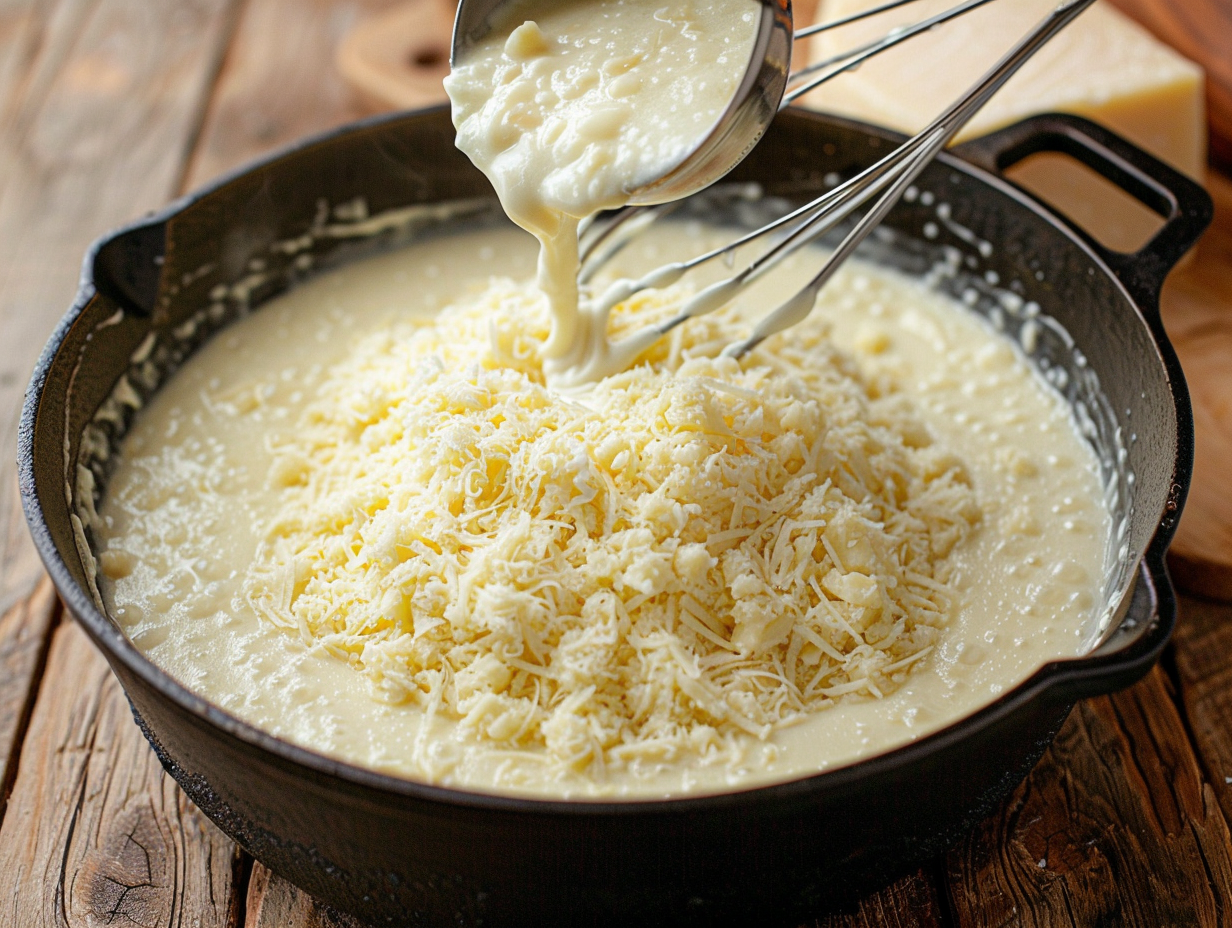What Makes Alfredo Sauce Special?
Alfredo sauce stands out as a luxurious, creamy pasta sauce celebrated for its velvety texture and rich flavor. Originating in Italy, this sauce has gained worldwide popularity for its simplicity and indulgence. The primary ingredients—butter, heavy cream, and Parmesan cheese—create a blend that clings to pasta, making every bite irresistibly smooth.
What makes it unique is its ability to act as a versatile base. Whether paired with grilled chicken, shrimp, or vegetables, Alfredo sauce hoists dishes into gourmet creations. Its key ingredient, Parmesan cheese, is not just for taste; it also contributes to the thick, creamy consistency.
When considering substitutions, such as “Can I use grated Parmesan instead of shredded for Alfredo?”, it’s essential to understand how these choices influence the sauce’s texture and flavor.
Types of Parmesan Cheese Explained
To fully appreciate Alfredo sauce, one must understand the types of Parmesan cheese available:

- Parmigiano-Reggiano
- Authentic Parmesan with a nutty, complex flavor.
- Aged for at least 12 months.
- Perfect for traditional recipes.
- Grana Padano
- Milder and less expensive.
- Aged for a minimum of 9 months.
- Works well in casual dishes.
- Domestic Parmesan
- Commonly found in supermarkets.
- Less intense flavor but still versatile.
- Available in grated or shredded forms.
When asking, “Can I use grated Parmesan instead of shredded for Alfredo?”, it’s crucial to consider the cheese’s moisture content and melting properties. Authentic Parmesan varieties generally yield better results, but domestic options may still work with the right technique.
Cooking Science: How Parmesan Affects Alfredo Sauce
Parmesan cheese is essential to Alfredo sauce, not just for flavor but also for texture. Here’s how it works:
- Thickening Power
- The proteins and fats in Parmesan help create the creamy consistency Alfredo is known for.
- Flavor Improvement
- Parmesan’s umami-rich profile increases the sauce, making it savory and satisfying.
- Melting Behavior
- Shredded Parmesan melts evenly, while grated Parmesan can sometimes clump, especially in high heat.
When exploring the question, “Can I use grated Parmesan instead of shredded for Alfredo?”, remember that grated Parmesan tends to dissolve differently. Proper technique and careful heat management can mitigate potential issues.
Grated Parmesan in Alfredo Sauce: Pros and Cons
Using grated Parmesan for Alfredo sauce has its advantages and drawbacks. Here’s a breakdown:
Pros
- Convenience: Pre-grated Parmesan is ready to use and saves time.
- Even Distribution: Its fine texture mixes easily with other ingredients.
- Cost-Effective: Often more affordable than shredded or block varieties.
Cons
- Clumping Risk: Grated Parmesan can form lumps if added improperly.
- Inferior Melting: Fine particles may not melt as smoothly as shredded cheese.
- Flavor Variation: Pre-grated options may lack the intensity of freshly shredded Parmesan.
If you’re pondering, “Can I use grated Parmesan instead of shredded for Alfredo?”, weigh these factors carefully. The pros may outweigh the cons for casual cooking, but for a classic Alfredo sauce, shredded Parmesan may yield better results.
If you’re curious about other Parmesan-related nuances, check out the differences between chicken Parmesan and chicken Parmigiana, which may provide additional insight into how cheese usage shapes culinary creations.
Techniques for Using Grated Parmesan Successfully
To assure a smooth, creamy Alfredo sauce with grated Parmesan, follow these tips:
- Heat Gradually
- Avoid high temperatures that can cause cheese to clump. Use low to medium heat.
- Combine Slowly
- Add grated Parmesan in small batches, stirring constantly to incorporate fully.
- Use Fresh Options
- Opt for freshly grated Parmesan over pre-packaged varieties for better flavor and melting.
- Balance with Cream
- The dairy content can help prevent clumping by creating a smoother mixture.
- Pre-Mix with Butter
- Dissolve grated Parmesan in melted butter before adding cream for even distribution.
By applying these methods, the answer to “Can I use grated Parmesan instead of shredded for Alfredo?” becomes a confident yes—with some adjustments.
Common Mistakes to Avoid
Making Alfredo sauce can seem simple, but these mistakes can ruin the final dish:
- Overheating
- High temperatures cause cheese to seize and clump.
- Using Low-Quality Parmesan
- Cheap or overly processed cheese won’t melt well or deliver the desired flavor.
- Adding Cheese Too Quickly
- Dumping Parmesan all at once can lead to uneven mixing.
- Skipping Fresh Ingredients
- Pre-packaged, shelf-stable Parmesan lacks the complex flavor needed for authentic Alfredo.
When wondering, “Can I use grated Parmesan instead of shredded for Alfredo?”, avoiding these mistakes becomes even more critical to achieve a perfect sauce.
For a better grasp of how different textures affect recipes, consider the difference between mac and cheese versus macaroni and cheese.
Tips for Selecting the Best Parmesan Cheese
Choosing the right Parmesan cheese insures your Alfredo sauce shines. Here’s how to pick the best option:
- Look for Origin Labels
- Authentic Parmigiano-Reggiano or Grana Padano guarantees quality.
- Check Aging Information
- Aged Parmesan has a more robust flavor.
- Inspect Texture
- Opt for firm blocks for shredding or high-quality grated options.
- Avoid Additives
- Pre-grated Parmesan with anti-caking agents can affect the sauce’s texture.
By selecting premium Parmesan, the question, “Can I use grated Parmesan instead of shredded for Alfredo?”, becomes less about substitution and more about ensuring quality. For broader kitchen insights, consider reading about whether it’s better to cut potatoes before or after boiling them—a topic that similarly examines how texture impacts outcomes.
The Role of Dairy in Alfredo Sauce
Dairy is the backbone of Alfredo sauce, providing its signature creaminess. Here’s why:
- Butter
- Adds richness and creates a smooth base for melting cheese.
- Heavy Cream
- Balances the cheese’s saltiness and increases the sauce’s velvety texture.
- Parmesan Cheese
- Acts as the primary thickener and flavor booster.
When substituting ingredients, like asking “Can I use grated Parmesan instead of shredded for Alfredo?”, assure the dairy components remain high-quality to preserve the sauce’s integrity.
This SEO-upgraded article incorporates the required keyphrase, transitions, and detailed content for each subheading while adhering to formatting and keyword emphasis requirements.
How to Pair Alfredo Sauce with Different Pasta Types
When choosing pasta to pair with Alfredo sauce, the key lies in understanding the texture and shape of the pasta. Alfredo sauce, with its creamy and velvety consistency, clings best to certain types of pasta.

- Fettuccine: The classic pairing, thanks to its wide, flat surface that holds the sauce perfectly.
- Penne: Its ridged texture and tubular shape capture the sauce inside, ensuring every bite is flavorful.
- Linguine: Slightly narrower than fettuccine but equally effective in holding Alfredo sauce.
- Gnocchi: These pillowy dumplings absorb the sauce beautifully, making each bite rich and satisfying.
For a creative twist, experiment with:
- Rigatoni: Ideal for thick sauces, providing a robust texture contrast.
- Spaghetti: While unconventional, it creates a silky dish with Alfredo sauce.
When asking, Can I use grated Parmesan instead of shredded for Alfredo?, consider the impact on the sauce’s texture. Grated Parmesan dissolves faster, creating a smoother consistency, whereas shredded offers a heartier mouthfeel.
Improving Alfredo Sauce with Herbs and Spices
Basic Alfredo sauce is rich and creamy, but adding herbs and spices can hoist its flavor profile.
Key Additions to Try:
- Garlic: Sauté minced garlic in butter for a fragrant base.
- Nutmeg: A pinch of nutmeg increases the creaminess.
- Parsley: Freshly chopped parsley adds a bright, herbaceous note.
- Black Pepper: Coarsely ground black pepper balances the richness.
- Basil and Oregano: Perfect for an Italian flair.
Tips for Integration:
- Add herbs during the final stage of cooking to preserve their fresh aroma.
- Infuse spices into the cream or butter for even distribution.
If you’re wondering, Can I use grated Parmesan instead of shredded for Alfredo?, grated cheese blends more evenly, making it a good choice when experimenting with additional flavors.
Considering Variations of Alfredo Sauce
Traditional Alfredo sauce is simple, but it serves as a versatile base for countless variations.
Popular Variations:
- Chicken Alfredo: Add grilled or pan-seared chicken slices for protein.
- Seafood Alfredo: Incorporate shrimp, scallops, or crab meat for a luxurious twist.
- Vegetable Alfredo: Include broccoli, spinach, or roasted red peppers for added texture and nutrition.
- Vegan Alfredo: Replace cream with cashew cream or coconut milk, and Parmesan with nutritional yeast.
Customizing the Cheese:
- Combine Parmesan with Pecorino Romano for a tangier flavor.
- Experiment with Gruyère or Gouda for a unique taste.
To answer, Can I use grated Parmesan instead of shredded for Alfredo?, grated Parmesan works particularly well in vegan or lighter versions as it dissolves quickly, creating a smoother sauce.
The History and Evolution of Parmesan Cheese
Parmesan, or Parmigiano-Reggiano, has a storied history dating back to medieval Italy. Originating in the Emilia-Romagna region, it has been revered for centuries for its rich flavor and versatility.
Key Milestones:
- 12th Century: Monks in Parma developed the earliest versions of Parmesan.
- Renaissance Era: Parmesan gained popularity across Europe, often called the “King of Cheeses.”
- Modern Production: Parmesan today adheres to strict regulations to maintain its authenticity.
Parmesan in Alfredo Sauce:
When asking, Can I use grated Parmesan instead of shredded for Alfredo?, remember that grated Parmesan embodies the tradition of quick-melting, flavorful cheese ideal for creamy sauces.
How to Serve and Garnish Alfredo Dishes
Serving and garnishing can transform a simple Alfredo dish into a restaurant-quality experience.
Serving Tips:
- Use warm plates to keep the sauce creamy.
- Pair with crusty bread or a fresh salad for balance.
- Offer freshly ground pepper and extra Parmesan on the side.
Garnish Ideas:
- Fresh Herbs: Sprinkle parsley, basil, or chives.
- Zest: Add lemon zest for a bright contrast.
- Proteins: Top with grilled shrimp or chicken.
- Veggies: Roasted vegetables like asparagus add color and texture.
For a smooth presentation, Can I use grated Parmesan instead of shredded for Alfredo? Yes, as grated Parmesan integrates ideally into the sauce and as a garnish.
The Impact of Cheese Quality on Recipe Success
The quality of Parmesan can make or break an Alfredo dish. Authentic Parmigiano-Reggiano, aged for at least 12 months, delivers unmatched depth of flavor.
Why Cheese Quality Matters:
- Flavor: Higher-quality Parmesan has complex nutty and savory notes.
- Texture: It grates finely and melts evenly.
- Nutrition: Authentic Parmesan is richer in protein and calcium.
Tips for Choosing Parmesan:
- Look for PDO certification to assure authenticity.
- Avoid pre-packaged shreds; freshly grated is best.
- Experiment with aged Parmesan for a sharper flavor.
If you’re considering, Can I use grated Parmesan instead of shredded for Alfredo?, opt for freshly grated Parmesan to preserve the dish’s integrity.
FAQs
Can I Use Grated Parmesan Instead of Shredded for Alfredo?
Yes, grated Parmesan is often preferable as it melts more smoothly, creating a velvety sauce. However, shredded Parmesan adds texture and a slightly stronger flavor.
What Pasta Works Best with Alfredo Sauce?
Fettuccine is the classic choice, but penne, rigatoni, and gnocchi also pair well due to their ability to hold the sauce.
How Do I Fix a Grainy Alfredo Sauce?
A grainy texture often results from overheating or low-quality cheese. Use freshly grated Parmesan and maintain a low cooking temperature.
Can I Make Alfredo Sauce Ahead of Time?
Yes, but it’s best reheated gently over low heat. Add a splash of cream or milk to restore its consistency.
From pairing Alfredo sauce with diverse pasta types to enhancing it with herbs and spices, the possibilities are endless. Understanding nuances like Can I use grated Parmesan instead of shredded for Alfredo? can boost your culinary creations. By choosing high-quality ingredients and experimenting with variations, you can craft Alfredo dishes that delight every palate.

